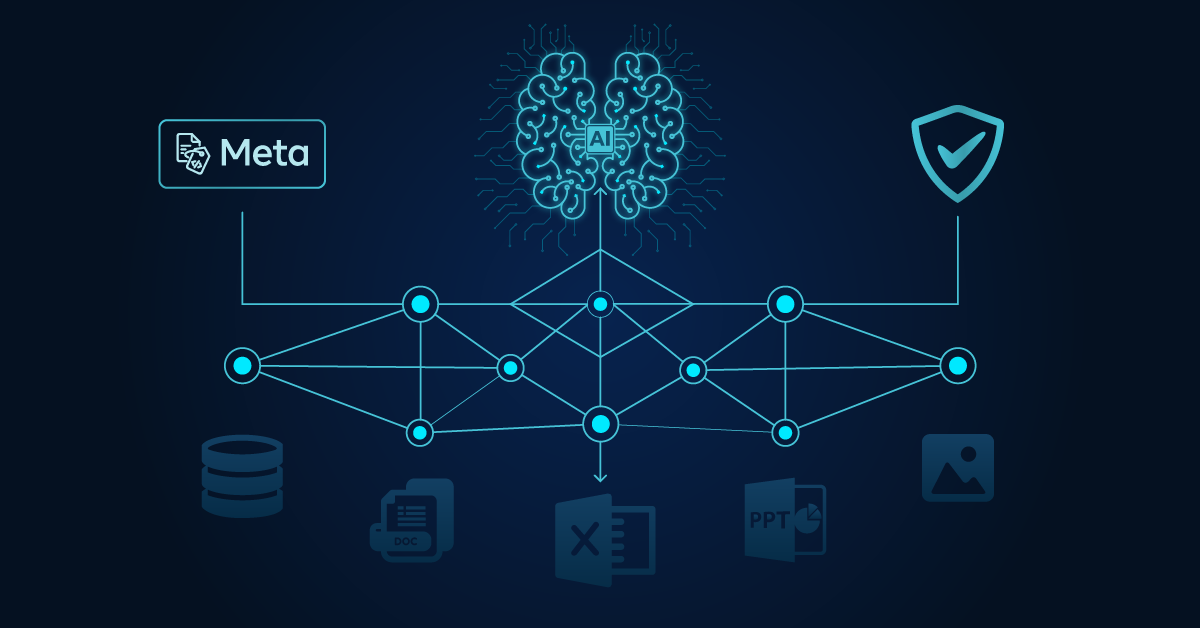9 minute read
Past & future use cases of Knowledge Graphs and AI integration
Explore real-world transformations with knowledge graphs and AI integration across industries. Learn about the synergy between KGs & AI-LLMs!
Table of contents
Knowledge Graphs (KGs) and Artificial Intelligence (AI)/Large Language Models (LLMs) affect the way we think and interact with AI technologies.
In this blog, we will learn about the potential of Knowledge Graphs in AI-LLMs, exploring real-world use cases across various industries.
The synergy between Knowledge Graphs and AI-LLMs and why integrate them
Integrating Knowledge Graphs with AI Large Language Models (LLMs) creates a powerful synergy that enhances the capabilities of artificial intelligence systems.
KGs are structured collections of interconnected entities, facts, and relationships, which provide a rich, contextual framework for data.
When combined with the advanced text processing and understanding abilities of AI-LLMs, this integration allows for a deeper and more nuanced comprehension of complex information.
This synergy enables AI to process and interpret data in a manner similar to human reasoning, improving decision-making, customer experiences, and innovation.
By incorporating the structured data and existing relationships from KGs, LLMs gain enhanced contextual understanding, allowing them to disambiguate meanings, recognise intricate connections, and generate more accurate and relevant responses.
This comprehensive integration not only expands the knowledge base of AI systems but also significantly boosts their performance across a variety of sophisticated tasks, making the combination of KGs and AI-LLMs a strategic advantage for businesses seeking to leverage AI technology effectively.
Real-world use cases in various industries
Knowledge Graphs in AI-LLMs have been successfully implemented across different industries, leading to innovative solutions and improved business outcomes.
1. Healthcare
Knowledge Graphs in AI-LLMs have already positively affected patient care and helped the healthcare sector a lot.

Personalised medicine
Artificial intelligence combined with Knowledge Graphs is significantly advancing personalised medicine in several impactful ways. With the use of KG and GenAI, it is possible to better understand patient data and build precision medicine frameworks.
We have at our disposal a large amount of patient data, such as genetic information, the way they live, medical records and the impact of the environment; all this data can now be studied and implemented thanks to AI-LLM and it is possible to make predictions about the development of certain diseases and treatments.
Projects like SPOKE (Scalable Precision Medicine Open Knowledge Engine) leverage KGs to connect patient electronic health records (EHRs) with extensive biomedical data.
Knowledge Graphs LLMs integration facilitates a precision medicine approach by enabling better management of diseases and predicting potential future medical conditions.
For example, SPOKE has been instrumental in the early detection of diseases like multiple sclerosis and Parkinson’s disease by integrating and analysing patterns between patient records and broader biomedical data.
Personalised treatment plans and healthcare predictions
The GraphCare framework generates personalised knowledge graphs by merging concept-specific KGs tailored to individual medical profiles. These personalised KGs are then utilised in AI models to make precise healthcare predictions.
This method significantly enhances the personalisation of healthcare by considering the unique medical history and needs of each patient.
Also, doctors and nurses can now create personalised treatment plans that take into account the differences between individuals in terms of genes, metabolism and other factors thanks to this diverse information.
Drug discovery and disease understanding
Thanks to KGs and GenAI/LLMs it is now possible to have a better drug discovery and disease understanding.
For example, AstraZeneca utilises disease-specific Knowledge Graphs to enhance understanding of complex diseases like idiopathic pulmonary fibrosis and chronic kidney disease.
These Knowledge Graphs compile vast networks of data on genes, proteins, diseases, and drugs, revealing crucial interactions and relationships that aid in drug discovery and disease understanding.
This approach not only accelerates the drug discovery process but also supports the repurposing of existing medicines for new disease indications.
Real-time clinical decision support
LLMs integration with Knowledge Graphs is significantly enhancing real-time decision support in healthcare, enabling faster and more precise clinical decisions.
AI-driven tools, referred to as Software as a Medical Device (SaMD), leverage real-world data to improve clinical decision-making. These tools help in monitoring diseases, developing digital therapeutics, and supporting diagnosis and treatment plans.
The continuous evaluation of these tools based on real-world data ensures their effectiveness across diverse patient groups and clinical settings (Margolis Institute for Health Policy).
AI-enhanced diagnostic accuracy
Johns Hopkins University and others have utilised AI to significantly speed up the analysis of medical images, such as CT scans, enhancing treatment decisions by predicting conditions like lung cancer much earlier than traditional methods.
Additionally, tools like Qure AI automate the generation of radiology report impressions, improving oncologist productivity and diagnostic speed (Medwave Billing & Credentialing).
2. Finance
AI and Knowledge Graphs are significantly enhancing the financial sector by streamlining complex data interactions and improving decision-making.

Fraud detection
Knowledge Graphs transform transactional data to reveal social and entity relationships, helping to identify groups that may require further investigation for fraud. This capability enhances the financial sector's ability to preempt and address fraudulent activities effectively.
These technologies can be used for transaction monitoring. Financial institutions leverage AI and Large Language Models to scrutinise vast amounts of transactional data in real-time, identifying unusual or suspicious patterns indicative of fraud or other financial crimes.
For instance, Morgan Stanley uses advanced chatbot technology powered by OpenAI to analyse massive datasets, enhancing customer service and fraud detection capabilities
Risk and opportunity detection
KGs in the financial sector are crucial for integrating diverse data types such as portfolio exposures, company structures, technological risks, and regulatory changes.
This integration already provides a solid foundation for identifying risks and opportunities. However, by incorporating GenAI and LLMs, the potential for precise and efficient decision-making is significantly amplified.
LLMs can analyse complex, unstructured data (like news articles, analyst reports, and social media feeds) and extract relevant insights that can be mapped onto the Knowledge Graph. This process enriches the graph with real-time, context-sensitive information, allowing for dynamic risk assessment and opportunity identification.
Furthermore, GenAI can automate the generation of predictive models based on the enriched Knowledge Graph, facilitating faster and more accurate forecasts of market trends and potential disruptions.
Risk assessment
The concepts of market risk analysis and credit risk evaluation using AI-LLMs are other two important areas actively explored and implemented in the financial sector.
AI-LLMs are increasingly being used to optimise risk management strategies by incorporating market data and economic indicators. These models can process and analyse vast amounts of financial data to identify market risks associated with investments, trading activities, and asset pricing variations.
The ability of LLMs to perform sentiment analysis and extract meaningful insights from financial documents plays a crucial role in this process. By integrating these capabilities with Knowledge Graphs, financial institutions can create a more holistic view of their data.
KGs link disparate data sources, including unstructured text from Large Language Models, to provide a comprehensive, interconnected data landscape. This enriched data environment enhances the predictive power of AI models, allowing for more accurate risk detection and assessment based on a broader array of information sources.
In the context of credit risk evaluation, AI-LLMs utilise Knowledge Graphs to analyse credit histories, financial statements, and market patterns. This enables more accurate assessment of a person's or company's creditworthiness.
By leveraging their extensive pre-training data and the ability to perform tasks through zero-shot learning, LLMs can automatically achieve satisfactory performance in sentiment classification and other text mining tasks on financial documents, thereby enhancing the credit risk evaluation process.
3. Retail and e-commerce
In the realm of retail and e-commerce, AI-LLMs and Knowledge Graphs are significantly enhancing the shopping experience and operational efficiency.

Product recommendations
AI-LLMs, by analysing user behaviour browsing history and purchase habits, enable more personalised product suggestions.
These models leverage KGs containing product details, descriptions, and reviews to tailor recommendations to the individual preferences of each user. This approach not only boosts customer satisfaction but also drives conversions and repeat purchases.
Personalised shopping experiences
AI-LLMs use Knowledge Graphs to generate dynamic content like product descriptions and ads based on individual user profiles and interests. This helps in creating more engaging and relevant shopping experiences.
Additionally, recommendation engines use these graphs to suggest similar or complementary items, optimising item placements and thereby increasing revenues and customer satisfaction.
Customer insights
Predictive analytics enabled by AI-LLMs can forecast future consumer behaviour demand by analysing past data and patterns. This capability allows e-commerce companies to make data-driven decisions, optimising inventory and stock handling.
Sentiment analysis using Knowledge Graphs helps in evaluating consumer sentiment from social media interactions and reviews, providing insights into product satisfaction and brand image.
Impact and benefits
Integrating KGs with AI-LLMs offers numerous benefits, including improved decision-making, enhanced data analysis, increased efficiency, and personalised user experiences. This synergy enables organisations to stay competitive in today's data-driven world.
Enhancing search and recommendation systems
For example, incorporating Knowledge Graphs and Large Language Models into search and recommendation systems can greatly enhance users' relevance and personalisation of results.
Here's how this can be achieved:
-
Semantic understanding:
AI-LLMs are provided to understand human speech and identify content or user queries' meaning from them. AI-LLMs can better understand complex search queries and assume user intent by using KGs to help them understand the meaning of user searches.
-
Contextual understanding:
Relevant information about organisations, such as their features, details, and connections to other entities, is provided by Knowledge Graphs. Due to this consideration, AI-LLMs can produce more relevant search results and recommendations that align with the user's preferences, interests, and intent.
-
Continuous learning and improvement:
AI-LLMs are constantly learning from user interactions and feedback to increase the accuracy and correctness of search results and suggestions over time. Through analysing user engagement data and updating the knowledge graph, businesses can improve their algorithms and provide users with increasingly personalised services.
Challenges
One of the primary challenges in using Knowledge Graphs in AI-LLMs is ensuring scalability and performance. As the volume of data increases, organisations need to optimise their infrastructure and algorithms to handle large-scale KGs effectively.
Another critical aspect of integrating Knowledge Graphs in AI-LLMs is addressing ethical considerations and data privacy issues. Organisations must prioritise data security, transparency, and user consent to maintain trust and compliance.
What's next? Potential new use cases on the horizon
a) Predictive maintenance in the automotive industry
To schedule maintenance just in time, predictive maintenance uses data analytics, machine learning, and artificial intelligence to forecast when machinery or equipment is likely to break.

In the automotive industry, this method predicts when specific car parts, like engines or brakes, might fail. AI-LLMs assess vast amounts of past maintenance data, including sensor data from cars, maintenance logs, and written descriptions of discovered problems.
By incorporating Knowledge Graphs, these Large Language Models can map and connect various data points, such as parts, failure modes, and maintenance histories, creating a comprehensive network of information.
This interconnected view allows AI-LLMs to understand complex patterns and correlations more deeply, enhancing their ability to predict when individual components may fail. This integration enables manufacturers to plan maintenance more effectively and minimise downtime.
b) Precision agriculture using sensor data and weather patterns
Precision agriculture is a farming method that increases the growth of crops and reduces the use of resources like fertiliser and water by using technology.

This approach involves using sensors to monitor crop health, soil moisture, and weather changes, and making data-driven decisions. By integrating Knowledge Graphs with AI-LLMs, the potential for understanding and analysing data is significantly enhanced.
KGs can organise and link various data sources, including agricultural research documents, historical weather records, farm sensor data, and expert knowledge.
This structured network of information helps AI-LLMs to understand complex relationships and correlations between data points. As a result, AI-Large Language Models can offer more precise insights, such as the optimal times for planting, watering schedules, pest management strategies, and crop selection based on climate and soil conditions.
The combination of Knowledge Graphs and AI-LLMs empowers farmers to comprehend complex data and make intelligent decisions that enhance agricultural productivity and sustainability.
c) Smart city initiatives integrating IoT devices with Knowledge Graphs and AI-LLMs
Innovative city programs aim to improve public services, transportation, utilities, infrastructure, and utilities to enhance citizens' quality of life.

This involves using advanced analytics with Internet of Things (IoT) devices, which collect data from energy meters, environmental sensors, and traffic cameras.
AI-LLMs can play an essential part in innovative city initiatives by analysing a lot of heterogeneous data, such as Knowledge Graphs that model connections among different city entities, social media feeds, municipal reports, and structured data from IoT devices.
From this data, AI-LLMs can obtain helpful information that can be used in various ways, such as forecasting traffic jams, seeing patterns in energy consumption, advising the best routes for emergency services, or even reading and answering questions from the general public.
Savvy city planners can use AI-LLMs to make data-driven decisions to increase urban efficiency, sustainability, and liveability.
Conclusion
In conclusion, introducing Knowledge Graphs into AI-LLMs presents many chances for game-changing solutions across several industries. By embracing this synergy, organisations may improve consumer experiences, make better decisions, and promote innovation in the quickly changing artificial intelligence sector.
In this article, we looked into the practical uses of the integration of Knowledge Graphs and AI-LLMs, highlighting how they impact various industries.
Intelligent systems that can digest, understand, and interact with data in more complicated ways are beginning a new era defined by combining Knowledge Graphs and AI-LLMs. This integration creates opportunities for AI technology development, study, and use.
Organisations must accept KGs as an essential transformation enabler as they go through the complex world of Artificial Intelligence technology and data-driven decision-making. In this digital age, companies may drive competitive advantage and create long-term value by investing in knowledge graph technologies and finding unique use cases.
Frequently Asked Questions
How do you combine LLM and knowledge graph?
To combine an LLM and a knowledge graph, you integrate the structured data from the knowledge graph into the LLM's analysis and generation process. This allows the LLM to leverage the detailed, interconnected information within the knowledge graph to enhance its understanding and improve the accuracy and contextuality of its responses. This approach is particularly useful in applications requiring deep understanding and complex decision-making, such as in smart city planning, healthcare, and personalised recommendations.
What are LLMs in artificial intelligence?
Large Language Models, or LLMs, are advanced AI models that can understand and produce those that match that of a human being after taking a great deal of training on a large amount of text.
What are some examples of integration of KG and LLMs?
Knowledge Graphs (KG) and Large Language Models (LLMs) can be interconnected in the following ways:
1. Knowledge-based Question Answering: Using KGs to provide LLMs structured data to produce responses to user questions that look like a human's.
2. Combining KGs to differentiate between entities mentioned in the text with LLMs to improve semantic search and information retrieval is known as entity linking and semantic search.
What are some benefits of using Large Language Models LLMs?
Using Large Language Models (LLMs) has several benefits, such as:
1. Improved Natural Language Understanding:
LLMs are very good at understanding and creating text that appears human, making it easier for humans and machines to communicate.
2. Flexibility and Adaptability:
LLMs are flexible tools that can be applied to a wide range of applications with minimal changes because they can be modified for different tasks and domains.


